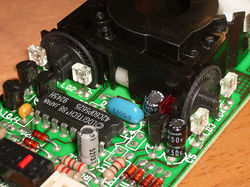Opto-mechanical sensor
Jump to navigation
Jump to search
This article is a stub. You can help Deskthority by expanding it.
For many years, mice and trackballs used opto-mechanical sensors to detect motion. Opto-mechanical sensing has been superceded by purely optical sensors.
Advantages
- Providing that the unit is in good condition and clean, sensing is 100% reliable on any flat surface; optical sensors can be fussy about what surfaces they will track on
Disadvantages
- High-maintenance: the rollers collect lint into a hard mass that must be regularly scraped off to restore reliable tracking
- Limited life: over time, the pressure spring weakens and the rollers lose their grip due to wear, leading to diminished reliability even when the button switches still function correctly; the expected lifetime of a ball mouse is uncertain and it likely depends on manufacturing standards, with lifetimes ranging from months to many years
Construction
The sensor comprises four main components:
- Ball
- In mice, a heavy ball able to move freely within a recess rolls across the mousing surface as the mouse is moved; in trackballs, the ball is rotated manually
- Rollers
- Three rollers make contact with the ball: the x and y motion axis rollers, and a 45° sprung pressure roller to keep the ball away from the inside walls of the recess and against the axis rollers; if this spring weakens, the ball can make contact with the recess and the mouse will seize up
- Opto-mechanical sensor
- The axis rollers turn shafts connected to slotted wheels. Light from light-emitting diodes shines through the wheel onto light sensors, and the motion of the wheels interrupting the passage of light from the LEDs to the light sensors allows the mouse to sense direction in each axis
- Controller
- A controller chip converts the signals from the sensors into motion, which is fed back to the computer
Gallery
x and y axis sensors in an Apple Desktop Bus Mouse

